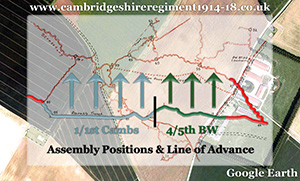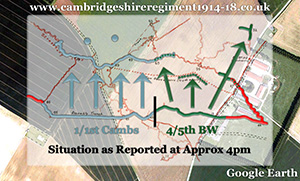
Who Were
The Cambs
The Cambs
at War
1/1st Btn 1914-1919
1914 - 1/1st Overview
1915 - 1/1st Overview
1915 - St Eloi
1915 - Fosse Wood
1916 - 1/1st Overview
1916 - The Schwaben
1916 - St Pierre Divion
1917 - 1/1st Overview
1917 - St Julien
Insignia, Medals & Books
Remembering The Cambs
Biographies
About Us &
This Site
The Cambridgeshires and the Schwaben Redoubt - October 14th & 15th 1916
Please Note – the main focus of these articles is of the Cambridgeshires role in the attack and defence of the North face of the Schwaben Redoubt. Details of the Black Watch and other units are included to explain the overall situation, however this is not written as a detailed account of their equally important part in the operation. While history has, in places, mainly credited the Cambridgeshires with the capture of the final section of the Redoubt, the part played by their comrades in the 118th Brigade and the 117th Brigade should not be overshadowed. For the 4/5th Black Watch the losses sustained in the operation, especially in the first few hours, exceeded those of the Cambridgeshires and there should be no doubt that both battalions paid a high price for the success.
Part 4 - The Assault
As the minutes ticked down to the start time, the men of the 1/1st Cambs and the 4/5th Black Watch readied for the off. The assembly had gone well and all troops were in positions, despite A Coy of the Cambs nearly getting lost and finally arriving with only four minutes to spare. The German defenders in the Schwaben had not managed to spot the troop build up. Although later research has shown that men were actually seen by the Germans on the far side of the Ancre valley, however the Schwaben defenders were not alerted in time.
As the officers nervously prepared to signal the advance, Riddell’s key element of surprise was nearly thrown away. After the 24-hour postponement and the subsequent shift forward by 30 minutes an error had somehow slipped into the plans. The order for most of the artillery units stated that the start time was now 2.46pm, a minute ahead of when the infantry were actually due to attack.
At exactly 2.46pm many of the artillery guns roared into action and the bombardment started. There was a moment of confusion in the assembly positions as watches were checked. On the left flank some men started to advance, while others waited for 2.47pm - the actual planned start time. Thankfully for the assaulting troops, the German defenders failed to spot the men who had started to advance. Somehow disaster had been narrowly averted. At 2.47 the rest of the first of four waves of infantry rose up and advanced.
On the left flank the Cambridgeshires advanced close behind the creeping artillery barrage as it crashed over no-man’s-land. The timing that the barrage shifted forward had been carefully worked out; even the fact that the terrible ground conditions would slow the infantry had been taken into consideration. Within seconds of the curtain of shells lifting from the German front line the first of the Cambridgeshires were leaping into the battered trenches. What greeted them was a scene of total confusion amongst the defenders.
On the right flank the advance of the Black Watch was not going as smoothly. Conflicting reports exist stating that they either advanced too far behind the creeping barrage, thus giving the Germans time to man their positions, or that they advanced too close to the barrage and suffered numerous casualties from the British artillery shells. Another account states that the advancing men were held up by a particularly thick and undestroyed section of barbed wire. Whichever version of events is true the end result was that many of the 4/5th men, particularly those to the left and center of their line of advance, were pinned down in shell holes in front of the German line. Heavy German machine gun fire both from their front and off to the far right started to inflict casualties on the floundering advance.
Off to the left the brutal and dirty job of clearing the trench network was well underway. Many of the German defenders were caught totally by surprise and those who tried to repel the Cambridgeshires were soon cut down by bomb, bayonet or bullet. Other defenders hid or took shelter in the deep dugouts hoping to avoid the carnage raging above ground. Accounts from those that took part in the initial trench clearing give a vivid picture of how effective the element of surprise had been, one Wisbech soldier later wrote home:
They called for mercy and put up their hands and ran like rats from dogs. I think it was one of the most happy days of my life. We put it about them properly.
Major Few, who was not part of the assault, noted that:
We took the Germans completely by surprise. A large number of the garrison were without boots and socks and there was also a fatigue party digging who were without arms.
Unlike the unfortunate Black Watch men, losses among the Cambridgeshires during the advance over no-man’s-land had been slight, but some had fallen either to shrapnel from the creeping barrage or to the sporadic fire from the few defenders who reacted in time. One of those lost was a young private from Chatteris called Charles Lambe. He was seen lying wounded in a shell hole but was later killed by artillery fire before the stretcher bearers could reach him. Like many of those killed in the muddy moonscape he has no known grave and is listed on the nearby Thiepval memorial.
As the next waves of attackers made their advance, the fighting all along the Redoubt intensified. The assaulting infantry pushed forward moving deeper into the trench network, leaving the next wave to clear the dugouts and organise the numerous prisoners. One of the most graphic accounts of the brutality of the trench clearing appears in the regimental history with Riddell writing:
It was grim work. The Germans had contested every foot of their ground. With bayonet and bomb the opposing sides had fought to a finish, as one pack of wolves fights another. In the daylight of the trenches, and the dark of the dug-outs, the battle raged. Hot blood, the lust of war, and fear, allowed no quarter being given or asked for. Those who wished to live must first kill.
A bayonet-fighting instructor, turning the corner of a deep trench, encountered a group of Boches. The men behind the instructor were in file, and were, therefore, unable to use their rifles. The Boches were in a similar position in regard to their leading man. Normally, the instructor was an an amiable, peaceful countryman, who in civil life would not have hurt a fly. Now he was fighting for his life. At first it was to save his own life that he killed: then blind madness took him. Thrusting, parrying, shouting, he beat down all opposition until every German was dead: eight men dead! Then the horror struck him. They took him away, lest he might go mad.
As the fighting moved on above ground the dangerous task of clearing the dugouts was started. If the shouts to surrender met with no response bombs (grenades) were thrown in, the explosions being quickly followed up by several heavily armed Cambridgeshires. Often the bombs did the work but in at least one of the dugouts things went badly wrong. While later checking the dugouts one D Coy Pte found three of his close friends all “past human aid”. Two of those mortally wounded in the dugout were Harold Bond from March and Ernest Benton from Ely.
As the last trenches in the Cambridgeshires section were being cleared and the dugouts searched, the third and forth waves of men arrived. These waves brought with them much of the heavier weapons and equipment that would be needed to secure the captured objective. Moving up with these waves came several Vickers guns and their crews from the 118th Machine Gun Coy. Many of the gun crews who volunteered to advance with the infantry were the men of the old Cambridgeshire Machine Gun Section, including Sgt Percy Walker who was later awarded the Military Medal for his gallantry at the Schwaben. The 118th Trench Mortar Battery also brought a trench mortar up into the ruins of the redoubt and vast stores of ammunition, barbed wire, sandbags and tools soon followed.
The situation off the right slowly started to improve as the Black Watch men doggedly pushed forward their attack, aided in places by the supporting 118th MGC guns. One gun crew, unable to reach their objective, engaged the remaining German defenders at near point blank range from a shell hole until all its crews were casualties. On to the far right of Black Watch attack some men overshot their objective, failing to recognise it among the shell-torn moonscape. These men took up a position in some trenches 100 yards beyond the objective, later falling back to the objective later under the cover of darkness.
Less than an hour after the attack had commenced the situation was looking good, especially when compared to the previous attempts on the position. Flying over the battlefield the crew of a Royal Flying Corps reconnaissance aircraft marked down the advance and dropped the maps behind the British lines. These maps and the reports coming back from the Redoubt clearly showed Riddell and the Brigade staff that while things were progressing well, the large gap between the Cambs and the Black Watch needed to be closed quickly. The fight for the Redoubt was by no means over and if anything the most dangerous challenge was still to come – the expected German counter attacks.
Part 5 - Strong Points and Riddell Trench
Back to the top of the page.
The Cambridgeshires & the Schwaben Redoubt
Part 1 - Background & History of the Redoubt
Part 2 - Riddell's Plan
Part 3 - Misfortune & Postponement
Part 4 - The Assault
Part 5 - Strong Points & Riddell Trench
Part 6 - Gallant Deeds
Part 7 - Counter-Attacks and Relief
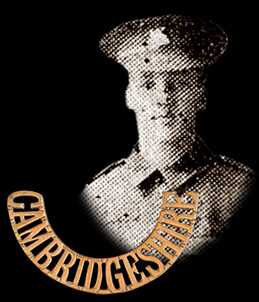
Pte Lambe, killed while crossing no-man's-land.
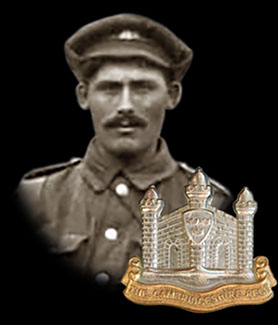
Cpl Benton, killed clearing dugouts.
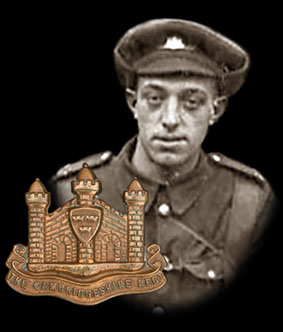
Cpl Bond, killed alongside Cpl Benton.
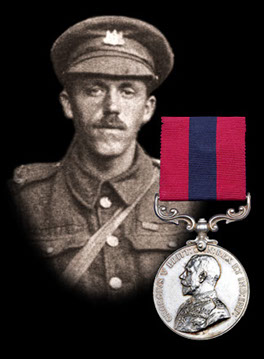
"Pop" Latham awarded the DCM for his gallantry at the Schwaben.

This site went live on the 14th February 2015 to mark 100 years since the 1/1st Cambs went off to war.
WE WILL REMEMBER THEM
Email us: cambsregt@gmail.com
Copyright 2015, 2016, 2017, 2018, 2019 by Felix Jackson. The information and images on this site should not be reproduced without prior permission.
